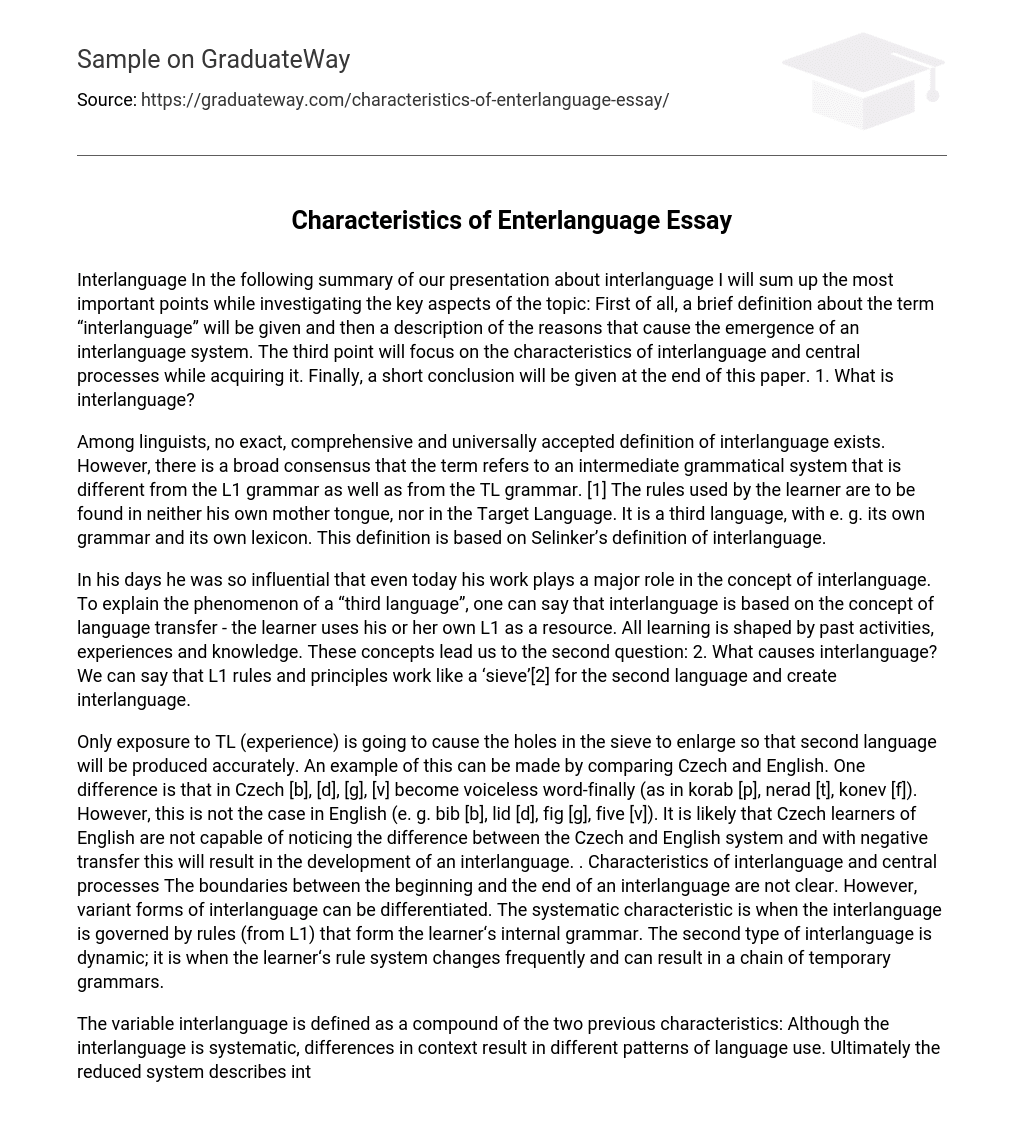Interlanguage In the following summary of our presentation about interlanguage I will sum up the most important points while investigating the key aspects of the topic: First of all, a brief definition about the term “interlanguage” will be given and then a description of the reasons that cause the emergence of an interlanguage system. The third point will focus on the characteristics of interlanguage and central processes while acquiring it. Finally, a short conclusion will be given at the end of this paper. 1. What is interlanguage?
Among linguists, no exact, comprehensive and universally accepted definition of interlanguage exists. However, there is a broad consensus that the term refers to an intermediate grammatical system that is different from the L1 grammar as well as from the TL grammar. [1] The rules used by the learner are to be found in neither his own mother tongue, nor in the Target Language. It is a third language, with e. g. its own grammar and its own lexicon. This definition is based on Selinker’s definition of interlanguage.
In his days he was so influential that even today his work plays a major role in the concept of interlanguage. To explain the phenomenon of a “third language”, one can say that interlanguage is based on the concept of language transfer – the learner uses his or her own L1 as a resource. All learning is shaped by past activities, experiences and knowledge. These concepts lead us to the second question: 2. What causes interlanguage? We can say that L1 rules and principles work like a ‘sieve’[2] for the second language and create interlanguage.
Only exposure to TL (experience) is going to cause the holes in the sieve to enlarge so that second language will be produced accurately. An example of this can be made by comparing Czech and English. One difference is that in Czech [b], [d], [g], [v] become voiceless word-finally (as in korab [p], nerad [t], konev [f]). However, this is not the case in English (e. g. bib [b], lid [d], fig [g], five [v]). It is likely that Czech learners of English are not capable of noticing the difference between the Czech and English system and with negative transfer this will result in the development of an interlanguage. . Characteristics of interlanguage and central processes The boundaries between the beginning and the end of an interlanguage are not clear. However, variant forms of interlanguage can be differentiated. The systematic characteristic is when the interlanguage is governed by rules (from L1) that form the learner‘s internal grammar. The second type of interlanguage is dynamic; it is when the learner‘s rule system changes frequently and can result in a chain of temporary grammars.
The variable interlanguage is defined as a compound of the two previous characteristics: Although the interlanguage is systematic, differences in context result in different patterns of language use. Ultimately the reduced system describes interlanguage in form and function, as a less complex grammatical structure (form) and a smaller range of communicative needs (function) typically served by an interlanguage. Furthermore, there are five central processes that cause interlanguage. The first one is Language Transfer where the learner uses his L1 as a resource for his L2.
The second process is the Transfer-of-Training which occurs whenever the effects of prior learning influence the performance of a later activity. For example, this could explain the difficulty of the distinction between “he” and “she” due to stronger usage of “he” in the learner’s textbooks. The third process is the Strategy of Second-language Learning and describes how learners approach the L2 materials and the task of L2 learning, with the learner’s tendency of simplifying the L2 system.
The forth central process is the Strategy of Second-language Communication, which describes ways that learners try to communicate with native speakers of the target language. The last process is called Overgeneralization which is the application of a form or rule not only to context where it applies, but also to other contexts where it does not apply (e. g. double negation). Again based on Selinker there has also been an expansion of these processes.
Among those are processes like simplification, where the learner uses speech that resembles that of very young children or U-shaped behavior, where the appearance of correct, or nativelike, forms occur at an early stage of development which then undergo a process of attrition 5. Conclusion Many IL linguistic structures are never really eradicated for most second language learners, manifestations of structures reappear in interlanguage productive performance especially under conditions of anxiety or shifting attention or something that is new for the learner.
It is natural that interlanguage occurs but it does not necessarily have to be negative; but it is important to retreat from the „mistakes“ and adjust the various “wrong” applications to relevant contexts. Bibliography: Books: Ellis, Rod (1994): The study of Second Language Acquisition. Oxford: Oxford University Press. Ortega, L. (2009): Chapter 6: Development of learner language. Understanding second language acquisition (110-144). London: Hodder Arnold. Saville-Troike, Muriel (2006): Introducing second language acquisition.
Cambridge: Cambridge University Press. Selinker, Larry (1972): Interlanguage. IRAL 10, 209-231. Trubetzkoy, N. S. Principles of Phonology. Univ of California Pr, 1969. Web: “Foreign Accent. ” 2008. Palacky University, Department of English and American Studies. 24 Jan. 2009 . Mason, Timothy. Interlanguage. 11 June 2009 . ———————– [1] “Foreign Accent. ” 2008. Palacky University, Department of English and American Studies. 24 Jan. 2009 . [2] N. S. Trubetzkoy, Principles of Phonology, 1939:51f





